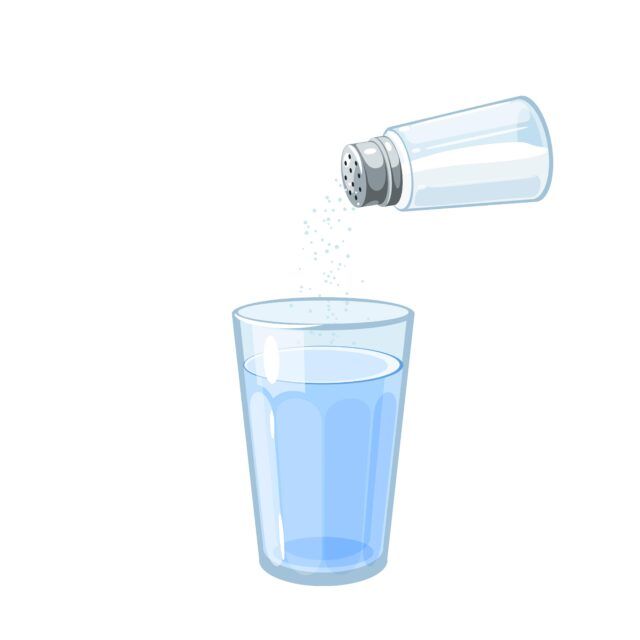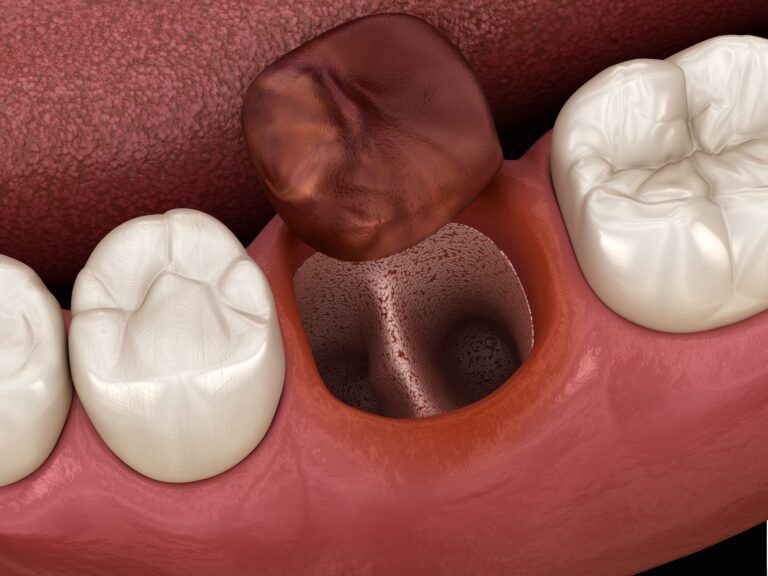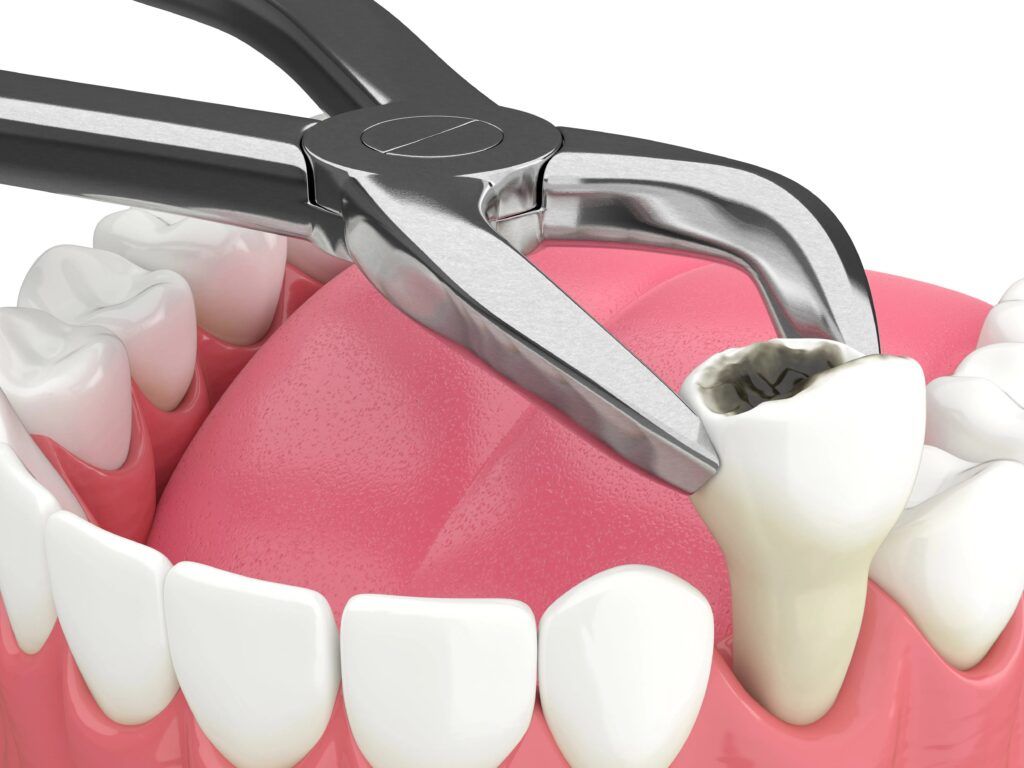Tooth extraction is a common dental procedure, often performed to pave the way for dental implant placement. While the thought of having a tooth removed can be daunting, understanding the recovery process can help ease any anxiety. Here’s what you can expect during the recovery phase after a tooth extraction in preparation for a dental implant:
Immediate Aftermath:

Immediately after having a tooth extraction, it’s common to experience some bleeding at the extraction site. Your dentist will typically place a gauze pad over the area, which you’ll need to bite down on to help control the bleeding. Some swelling and bruising may also occur, and applying a cold pack to the cheek or jaw in 15-minute intervals can help reduce this. Pain is a natural part of the healing process, and your dentist may prescribe pain relievers or recommend over-the-counter painkillers to manage discomfort. It’s essential to avoid rinsing your mouth, spitting forcefully, or drinking through a straw for the first 24 hours, as these actions can dislodge the blood clot forming in the socket, leading to complications. Additionally, it’s advisable to rest and avoid vigorous physical activity for a day or two to promote healing.
Oral Hygiene:
After a tooth extraction, maintaining proper oral hygiene is crucial to prevent complications and promote healing. Here’s a guide to the oral hygiene practices one should follow post-extraction:

- Avoid Rinsing for the First 24 Hours: It’s essential not to rinse your mouth for the first 24 hours after the extraction to allow the formation of a stable blood clot in the socket.
- Salt Water Rinses: After the initial 24 hours, gently rinse your mouth with warm salt water (about a half teaspoon of salt in a cup of warm water) several times a day. This helps to soothe the extraction site and reduce the risk of infection.
- Gentle Brushing: Continue brushing your teeth as usual, but be very gentle around the extraction site for the first few days to avoid dislodging the blood clot. Avoid using electric toothbrushes near the extraction site during this period.
- Avoid Using Mouthwash: Commercial mouthwashes can be too harsh on the extraction site. If you wish to use a mouthwash, opt for a mild, alcohol-free version or stick to salt water rinses.
- No Smoking: Smoking can interfere with the healing process and increase the risk of complications like dry socket. It’s best to avoid smoking for at least 72 hours after the procedure, or longer if possible.
- Avoid Using Straws: Drinking through a straw can create a suction that might dislodge the blood clot in the extraction socket. Refrain from using straws for at least a week post-extraction.
- Watch for Signs of Infection: While maintaining good oral hygiene significantly reduces the risk, it’s essential to be vigilant for signs of infection, such as persistent pain, swelling, bad taste, or fever. If you notice any of these symptoms, contact your dentist immediately.
In summary, gentle care and cleanliness are paramount after a tooth extraction. By following these oral hygiene practices, you can ensure a smooth recovery and reduce the risk of potential complications.
Dietary Adjustments:
After undergoing a tooth extraction, making thoughtful dietary choices is essential not only for comfort but also to ensure proper healing. Here are some dietary adjustments to consider:
Soft Foods:
In the initial days following the extraction, stick to soft foods that require minimal chewing. Examples include:
- Yogurt or pudding
- Applesauce
- Mashed potatoes
- Scrambled eggs
- Broths and soups (not too hot)
- Smoothies (consume with a spoon to avoid using straws)
Stay Hydrated:
Drink plenty of water to stay hydrated. However, remember to sip gently and avoid using straws, as the suction can dislodge the blood clot forming in the extraction site.
Avoid Hot Foods and Beverages:
Extremely hot foods and drinks can disrupt the blood clot and delay the healing process. Wait for your meals to cool down to a lukewarm temperature before consuming.
Steer Clear of Hard and Crunchy Foods:
Foods like nuts, popcorn, chips, and hard candies can irritate the extraction site and even get lodged in the socket. It’s best to avoid these until the healing process is well underway.
Limit Sugary and Acidic Foods:
Excessive sugar can increase the risk of bacterial growth, leading to infections. Similarly, acidic foods and beverages, like citrus fruits and sodas, can irritate the extraction site. Consume these in moderation and ensure you rinse your mouth with water afterward.
No Alcoholic Beverages:
Alcohol can interfere with the healing process and may interact with any pain medications or antibiotics prescribed by your dentist. It’s best to avoid alcohol for at least 72 hours post-extraction.
Gradual Transition:
As the extraction site begins to heal, you can gradually reintroduce firmer foods into your diet. However, always be cautious and avoid biting down directly on the extraction site for several weeks.
Vitamin and Mineral Boost:
Consuming foods rich in vitamins and minerals, especially vitamin C and calcium, can promote faster healing. Consider foods like spinach, kale, fortified cereals, dairy products, and oranges.
While the dietary adjustments post-tooth extraction might seem restrictive, they play a crucial role in ensuring a smooth and complication-free recovery. By being mindful of your food choices and prioritizing gentle, nutritious options, you can set the stage for optimal healing and comfort.
Potential Complications:

After a tooth extraction, while many people experience an uneventful recovery, there are potential complications to be aware of. One of the most common issues is dry socket, which occurs when the blood clot that forms in the extraction site becomes dislodged or dissolves prematurely, exposing the underlying bone and nerves. This condition can lead to intense pain and a foul odor in the mouth. Infections are another concern; signs include persistent pain, swelling, fever, and a bad taste in the mouth. Additionally, there’s a risk of accidental damage to surrounding teeth, gums, or jawbone during the extraction. In rare cases, a condition called osteomyelitis, a bone infection, can develop. Prolonged bleeding and swelling beyond the initial 48 hours can also indicate a problem. It’s essential to maintain good oral hygiene and follow post-operative instructions to minimize these risks and to contact your dentist immediately if you suspect any complications.
Preparing for the Implant:
Preparing for dental implant placement after a tooth extraction involves several steps to ensure the implant’s success and longevity. Here’s what’s typically needed:
- Healing Time: After an extraction, the site needs adequate time to heal before implant placement. This can range from several weeks to a few months, depending on individual factors and the complexity of the extraction.
- Bone Grafting: If there isn’t sufficient bone to support an implant, a bone graft may be necessary. This procedure involves placing bone material (either from the patient, a donor, or synthetic sources) into the extraction site to promote bone growth. The grafted material provides a scaffold for new bone to grow and can be done immediately after extraction or at a later date.
- Sinus Lift (for upper jaw implants): If the implant is to be placed in the upper jaw and there’s not enough bone height, or the sinuses are too close to the jaw, a sinus lift might be required. This procedure involves raising the sinus floor and developing bone for the implant.
- Evaluation and Planning: Detailed dental X-rays or a CT scan may be taken to assess bone quality, determine the exact position for the implant, and to check the location of nerves and sinuses.
- Oral Health Assessment: Good oral health is crucial for the success of a dental implant. Issues like gum disease must be addressed before implant placement. Regular cleaning and addressing other dental problems will set a healthy foundation for the implant.
- Tobacco Cessation: Smoking or using tobacco products can hinder the healing process and decrease the success rate of dental implants. It’s recommended to quit smoking before undergoing implant surgery.
- Discussion of the Procedure: Before the implant procedure, the dentist or oral surgeon will discuss the entire process, the type of implant being used, the stages involved, and the expected recovery timeline.
- Dental Implant Design: Depending on the patient’s specific needs and the condition of the jawbone, the dental professional will decide on the type of implant and the method of placement.
In summary, preparing for a dental implant after a tooth extraction involves ensuring optimal bone quality, addressing any oral health issues, and meticulous planning to achieve the best possible outcome. Proper preparation and following the dentist’s guidelines can significantly increase the likelihood of a successful and long-lasting implant.
In Conclusion:
Recovering from a tooth extraction requires patience and diligent aftercare. By following your dentist’s advice and being aware of what to expect, you can ensure a smooth recovery and successful preparation for your dental implant. Remember, the end goal is a strong, healthy smile, and each step of the process brings you closer to that objective.

